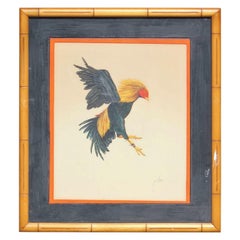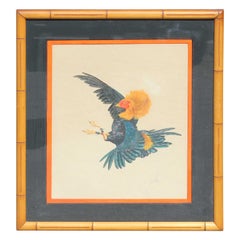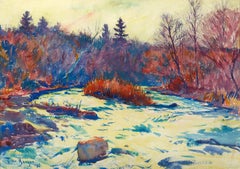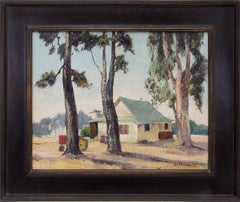Lem Palmer Paintings
to
2
1
1
Overall Width
to
Overall Height
to
4
1
2
1
1
2
2
2
2
1
1
4
3
2
1
4
788
690
653
569
1
4
Artist: Lem Palmer
"Cock Fighting" Facing Right
By Lem Palmer
Located in Houston, TX
Illustrated roosters in the action of fighting. Part of a pair by the artist Lem Palmer.
Framed in a wooden frame.
Category
20th Century Contemporary Lem Palmer Paintings
Materials
Gouache
Rural Stylized Watercolor Landscape Painting
By Lem Palmer
Located in Houston, TX
Rural landscape painting in an idealized style. The painting is done in watercolor and is signed by the artist in the bottom left corner. Lem Palmer is known for his stylized landsca...
Category
1980s Impressionist Lem Palmer Paintings
Materials
Watercolor
Naturalistic Western Landscape with Wagon and Cow Skull
By Lem Palmer
Located in Houston, TX
Warm tonal landscape western painting with a cow skull in the immediate foreground and a wagon in the midground. The painting is signed by the artist Lem Pa...
Category
Mid-20th Century American Modern Lem Palmer Paintings
Materials
Oil
"Cock Fighting" Facing Left
By Lem Palmer
Located in Houston, TX
Illustrated roosters in the action of fighting. Part of a pair by the artist Lem Palmer.
Framed in a wooden frame.
Category
20th Century Contemporary Lem Palmer Paintings
Materials
Gouache
Related Items
Sun Glare, 1923
By Frank Weston Benson
Located in New York, NY
Frank Weston Benson paints a river surging through a forest landscape in his intriguing watercolor rendering entitled, “Sun Glare.”
Category
Early 20th Century Impressionist Lem Palmer Paintings
Materials
Paper, Watercolor, Pencil
1950s Old Airfield in Capitola, California Landscape Oil Painting with Trees
By Jon Blanchette
Located in Denver, CO
This vintage 1950s-1960s oil painting titled 'Old Airfield in Capitola, California' beautifully captures a serene Northern California landscape. The scene depicts a lush countryside with vibrant trees, a charming white house with a green roof, a red tractor...
Category
Mid-20th Century American Modern Lem Palmer Paintings
Materials
Oil
H 23 in W 27 in D 1.125 in
Morning Sunrise, Mid Century Laguna Hills Figurative Landscape
Located in Soquel, CA
Beautiful mid century plein air figural landscape of Laguna Niguel, California by an unknown artist (American, 20th Century). The morning sun gli...
Category
1950s American Modern Lem Palmer Paintings
Materials
Canvas, Oil, Cardboard
Big Sur California Seascape Original Mid-Century Oil on Linen
Located in Soquel, CA
Big Sur California Seascape Original Mid-Century Oil on Linen
Exceptional Seascape ainting in Oil Impasto technique by Ralph Victor Murray (American, 1897-1991). Heavy brush work of the Big Sur Coast rocks and crashing waves. In a period rustic carved frame.
Image 24"H x 30.88"W
Frame 28.25"H x 35.25"W x 2"D, frame is rustic and has some edge wear included as-is.
Ralph Victor Murray was born June 27, 1897 in Fredericton, New Brunswick, Canada. He was raised in Fredericton and Campbellton. He was living in Campbellton in 1910 and witnessed the whole town burn to the ground. He studied at Rothesay Academy and left school at the age of 15 to help support his mother and sisters when his father passed away. He joined the Canadian Expeditionary Forces at age 18 and served during World War 1 in England until he was stricken with Diptheria and transferred to Halifax. He was walking to work on Dec. 16, 1917 when the great explosion of Halifax took place.
After leaving the military, he traveled and worked in Canada and the United States until he ended up in San Francisco. While there he heard the California Highway Division was hiring, so he took the test and was hired as a surveyor. From 1923 to 1924 he surveyed Highway One (The Big Sur Highway) between Santa Maria and Carmel. He was retired from the State of California in 1940 and took up oil painting.
In 1941 he won 2nd place in the Santa Cruz County Fair. He was mostly self taught, however he did take some private lessons from Burton Boundey and Abel Warshawsky. His work was landscapes and seascapes in oils. He was a lifetime member of the Carmel Art Association in Carmel, California. He frequently exhibited his work there from 1940-1960. His work was also exhibited in Wells Fargo Bank, Cal Am Water Co., Monterey Savings and Loan, Pacific Gas and Electric and numerous other businesses around the Monterey Peninsula. His work was shown in the "Monterey Peninsula Herald" and was also photographed for the L. A. Times for the July 20, 1958 insert.
In the 1960's he gave private lessons to Helen Barker and Charles Lee. He also showed his work in the Helen Barker Gallery in Carmel, California. He was featured under People in the February, 1989 issue of Monterey Life. The California Art Review solicited information from him as well as California Artists.
His friends and peers were such greats as Abel Warshawsky, Frank Meyers, Myron Oliver, Armin Hansen, Arthur Hill Gilbert, Burton Boundey and Leslie Emery...
Category
1950s American Modern Lem Palmer Paintings
Materials
Linen, Oil, Stretcher Bars
H 28.25 in W 35.25 in D 2 in
Van's Grocery, Aptos Village - Mid Century California Landscape
By Jon Blanchette
Located in Soquel, CA
Beautiful mid century watercolor of a little store in Aptos, California by listed artist Jon Blanchette (American, 1908-1987). Signed "Jon Blanchette" lower right. Presented in a new...
Category
Mid-20th Century American Impressionist Lem Palmer Paintings
Materials
Cardboard, Permanent Marker, Watercolor
H 12 in W 15 in D 0.25 in
House in Hudson, Ohio, Late 19th Century Painting by Cleveland School Artist
Located in Beachwood, OH
Ora Coltman (American, 1858-1940)
House in Hudson, OH
Oil on canvas
Signed lower left
22 x 26 inches
27.5 x 31.5 inches, framed
21 Aurora Street is locally known as the Isham-Beebe ...
Category
Late 19th Century American Modern Lem Palmer Paintings
Materials
Oil
"Spanish Moss, Georgia" Georgina Klitgaard, Modernist Southern Flora Painting
By Georgina Klitgaard
Located in New York, NY
Georgina Klitgaard
Spanish Moss, Georgia
Signed lower right
Oil on artist's board
12 x 16 inches
Georgina Klitgaard’s art has sometimes gotten lost in the critical propensity to as...
Category
Mid-20th Century American Modern Lem Palmer Paintings
Materials
Canvas, Oil
"Train Station, " Max Kuehne, Industrial City Scene, American Impressionism
By Max Kuehne
Located in New York, NY
Max Kuehne (1880 - 1968)
Train Station, circa 1910
Watercolor on paper
8 1/4 x 10 1/4 inches
Signed lower right
Provenance:
Private Collection, Illinois
Max Kuehne was born in Halle, Germany on November 7, 1880. During his adolescence the family immigrated to America and settled in Flushing, New York. As a young man, Max was active in rowing events, bicycle racing, swimming and sailing. After experimenting with various occupations, Kuehne decided to study art, which led him to William Merritt Chase's famous school in New York; he was trained by Chase himself, then by Kenneth Hayes Miller. Chase was at the peak of his career, and his portraits were especially in demand. Kuehne would have profited from Chase's invaluable lessons in technique, as well as his inspirational personality. Miller, only four years older than Kuehne, was another of the many artists to benefit from Chase's teachings. Even though Miller still would have been under the spell of Chase upon Kuehne's arrival, he was already experimenting with an aestheticism that went beyond Chase's realism and virtuosity of the brush. Later Miller developed a style dependent upon volumetric figures that recall Italian Renaissance prototypes.
Kuehne moved from Miller to Robert Henri in 1909. Rockwell Kent, who also studied under Chase, Miller, and Henri, expressed what he felt were their respective contributions: "As Chase had taught us to use our eyes, and Henri to enlist our hearts, Miller called on us to use our heads." (Rockwell Kent, It's Me O Lord: The Autobiography of Rockwell Kent. New York: Dodd, Mead and Co., 1955, p. 83). Henri prompted Kuehne to search out the unvarnished realities of urban living; a notable portion of Henri's stylistic formula was incorporated into his work.
Having received such a thorough foundation in art, Kuehne spent a year in Europe's major art museums to study techniques of the old masters. His son Richard named Ernest Lawson as one of Max Kuehne's European traveling companions. In 1911 Kuehne moved to New York where he maintained a studio and painted everyday scenes around him, using the rather Manet-like, dark palette of Henri.
A trip to Gloucester during the following summer engendered a brighter palette. In the words of Gallatin (1924, p. 60), during that summer Kuehne "executed some of his most successful pictures, paintings full of sunlight . . . revealing the fact that he was becoming a colorist of considerable distinction." Kuehne was away in England the year of the Armory Show (1913), where he worked on powerful, painterly seascapes on the rocky shores of Cornwall. Possibly inspired by Henri - who had discovered Madrid in 1900 then took classes there in 1906, 1908 and 1912 - Kuehne visited Spain in 1914; in all, he would spend three years there, maintaining a studio in Granada. He developed his own impressionism and a greater simplicity while in Spain, under the influence of the brilliant Mediterranean light. George Bellows convinced Kuehne to spend the summer of 1919 in Rockport, Maine (near Camden). The influence of Bellows was more than casual; he would have intensified Kuehne's commitment to paint life "in the raw" around him.
After another brief trip to Spain in 1920, Kuehne went to the other Rockport (Cape Ann, Massachusetts) where he was accepted as a member of the vigorous art colony, spearheaded by Aldro T. Hibbard. Rockport's picturesque ambiance fulfilled the needs of an artist-sailor: as a writer in the Gloucester Daily Times explained, "Max Kuehne came to Rockport to paint, but he stayed to sail." The 1920s was a boom decade for Cape Ann, as it was for the rest of the nation. Kuehne's studio in Rockport was formerly occupied by Jonas Lie.
Kuehne spent the summer of 1923 in Paris, where in July, André Breton started a brawl as the curtain went up on a play by his rival Tristan Tzara; the event signified the demise of the Dada movement. Kuehne could not relate to this avant-garde art but was apparently influenced by more traditional painters — the Fauves, Nabis, and painters such as Bonnard. Gallatin perceived a looser handling and more brilliant color in the pictures Kuehne brought back to the States in the fall. In 1926, Kuehne won the First Honorable Mention at the Carnegie Institute, and he re-exhibited there, for example, in 1937 (Before the Wind). Besides painting, Kuehne did sculpture, decorative screens, and furniture work with carved and gilded molding. In addition, he designed and carved his own frames, and John Taylor Adams encouraged Kuehne to execute etchings. Through his talents in all these media he was able to survive the Depression, and during the 1940s and 1950s these activities almost eclipsed his easel painting. In later years, Kuehne's landscapes and still-lifes show the influence of Cézanne and Bonnard, and his style changed radically.
Max Kuehne died in 1968. He exhibited his work at the National Academy of Design, the Art Institute of Chicago, the Carnegie Institute in Pittsburgh, the Memorial Art Gallery of the University of Rochester, and in various New York City galleries. Kuehne's works are in the following public collections: the Detroit Institute of Arts (Marine Headland), the Whitney Museum (Diamond Hill...
Category
1910s American Impressionist Lem Palmer Paintings
Materials
Paper, Watercolor
Modernist Abstract Expressionist Watercolor Painting Bauhaus Weimar Pawel Kontny
By Pawel Kontny
Located in Surfside, FL
Abstract watercolor composition bearing the influence of the earlier color-block compositions of Paul Klee.
Pawel August Kontny, (Polish-German-American artist) He was born in Laurahuette, Poland, in 1923, the son of a wealthy pastry shop owner. In 1939 he began studying architecture in Breslau where he was introduced to the European masters and to the work of some of the German Expressionists, soon afterward banned as "degenerate artists" and removed from museums throughout Germany by the Nazi regime. His studies were interrupted by World War II. Drafted into the German army, traveling in many countries as a soldier, he sketched various landscapes but in 1945, he was captured and held as a prisoner of war in Italy. After the war, he studied at the Union of Nuremberg Architects to help design buildings to replace ones destroyed in the war. He recorded his impressions of the local population and the landscapes through his watercolors and drawings. Pawel Kontny thereafter moved to Nuremberg, Germany, becoming a member of the Union of Nuremberg Architects and helping to rebuild the city's historic center. He soon decided to concentrate on his professional art career. He married Irmgard Laurer, a dancer with the Nuremberg Opera. Pavel Kontny 's career as an artist was launched with his participation in an all German exhibition, held at the Dusseldorf Museum in 1952. He held one-man shows in Germany, Switzerland and the United States. During his trip to the United States in 1960, Kontny became instantly enamored with Colorado, and decided to relocate to Cherry Hills with his wife and two children. He quickly established himself in the local art community, being affiliated for a time with Denver Art Galleries and Saks Galleries. His subject matter became the Southwest. During this time he received the Prestigious Gold Medal of the Art Academy of Rome. His extensive travel provided material for the paintings he did using his hallmark marble dust technique. he also worked equally in pastel, watercolor, charcoal and pencil-and-ink. in a style which merged abstraction and realist styles, influenced by Abstract Expressionist painting and South Western American landscapes. In the early 1960s he was one of only a few European-born professional artists in the state, a select group that included Herbert Bayer (1900-1985), a member of the prewar Bauhaus in Weimar and Dessau, Germany, and Roland Detre (1903-2001), a Hungarian modernist painter. As a Denver, Colorado resident, Pavel Kontny exhibited at galleries and museums throughout the United States, Germany and Japan. There, he was inspired by frequent trips to Native American pueblos in the Southwest, as well as by the study of the Plains Indians of Montana and Wyoming. Over the years Kontny had a number of students and generously helped young artist by hosting exhibitions at his Cherry Hills home. For many years he generously donated his paintings to support charitable causes in Denver. Influences during his European years included German pastelist C.O. Muller, German Informel painter Karl Dahmen and Swiss artist, Hans Erni. In the early 1950s his painting style showed the influence of the Die Brücke (The Bridge), a group of German expressionist artists formed in Dresden in 1905 who had a major impact on the evolution of modern art in the twentieth century in Germany. By the middle of the decade his style incorporated more referential abstraction and total abstraction, resulting in part from his study of Hans Hartung, a German artist based in Paris who exhibited his gestural abstract work in Germany. The American moon landing in 1969 inspired Paul Kontny...
Category
20th Century American Modern Lem Palmer Paintings
Materials
Canvas, Oil
Missouri American Modernist famous in Europe - abstracted mid century Venice
Located in Norwich, GB
Meet the genuinely exciting modernist William Einstein, who is probably better known in Europe, where numerous publications on his work have been written, than in his native US!
Eins...
Category
1950s American Modern Lem Palmer Paintings
Materials
Canvas, Oil
Colorado Mining Town, Early Sunday Morning - Modernist Mountain Landscape
By Paul Kauvar Smith
Located in Denver, CO
This captivating original mountain landscape by the talented Paul K. Smith brings to life the beauty and historical charm of Colorado’s mining heritage. Painted in the 1930s-1950s, the artwork likely depicts one of Colorado's iconic historic mining towns...
Category
1930s American Modern Lem Palmer Paintings
Materials
Oil
"Fodder Stacks, Bearsville" Georgina Klitgaard, Modernist Country Landscape
By Georgina Klitgaard
Located in New York, NY
Georgina Klitgaard
Fodder Stacks, Bearsville
Signed lower right
Oil on canvas
24 x 30 inches
Georgina Klitgaard’s art has sometimes gotten lost in the critical propensity to assign...
Category
Early 20th Century American Modern Lem Palmer Paintings
Materials
Canvas, Oil
Lem Palmer paintings for sale on 1stDibs.
Find a wide variety of authentic Lem Palmer paintings available for sale on 1stDibs. You can also browse by medium to find art by Lem Palmer in paint, watercolor, gouache and more. Much of the original work by this artist or collective was created during the 20th century and is mostly associated with the contemporary style. Not every interior allows for large Lem Palmer paintings, so small editions measuring 22 inches across are available. Customers who are interested in this artist might also find the work of Steven Gandhi, Sally-Ann Johns, and Clive Meredith. Lem Palmer paintings prices can differ depending upon medium, time period and other attributes. On 1stDibs, the price for these items starts at $1,200 and tops out at $2,500, while the average work can sell for $1,200.



